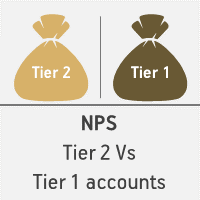Differences Between Tier 1 and Tier 2 NPS Accounts


The National Pension System (NPS) in India offers two primary account types: Tier I and Tier II. While both accounts are part of the NPS framework, they serve different purposes and have distinct features. In this article, we'll delve into the differences between Tier I and Tier II NPS accounts to help you understand which one may be suitable for your financial goals and retirement planning needs.
1. Purpose and Usage:
Tier I NPS Account:
Purpose: Tier I NPS accounts are designed specifically for retirement savings and long-term wealth accumulation.
Usage Restrictions: Contributions to Tier I accounts are subject to lock-in periods and withdrawal limitations, making it a long-term investment vehicle. Withdrawals are allowed only upon reaching retirement age or meeting specific criteria such as partial withdrawals for specific purposes like higher education, home purchase, or critical illness treatment.
Tax Benefits: Contributions to Tier I NPS accounts qualify for tax benefits under Section 80CCD(1) of the Income Tax Act, offering deductions up to a specified limit.
Mandatory Contribution: For employees under the Corporate NPS, it is mandatory to contribute to Tier I accounts, with contributions typically deducted from salary.
Tier II NPS Account:
Purpose: Tier II NPS accounts serve as voluntary investment accounts for short to medium-term savings and liquidity needs.
Usage Flexibility: Unlike Tier I accounts, Tier II accounts do not have lock-in periods or withdrawal restrictions, offering higher flexibility in accessing funds as needed.
No Tax Benefits: Contributions to Tier II NPS accounts do not qualify for additional tax benefits beyond what is available for Tier I contributions.
Voluntary Contribution: Tier II accounts are optional and can be opened independently or in addition to Tier I accounts, allowing individuals to invest additional funds beyond their mandatory Tier I contributions.
2. Withdrawal Flexibility:
Tier I NPS Account:
Withdrawal Restrictions: Tier I NPS accounts have stringent withdrawal rules, with partial withdrawals permitted only under specific circumstances and subject to prescribed conditions.
Retirement Benefits: At retirement age, investors can withdraw a portion of their accumulated corpus as a lump sum (up to a specified limit) and use the remaining amount to purchase an annuity for regular pension income.
Tier II NPS Account:
Withdrawal Freedom: Tier II NPS accounts offer unrestricted withdrawal options, allowing investors to withdraw funds anytime without penalties or lock-in periods.
Liquid Savings: Tier II accounts function more like a liquid savings account, providing quick access to funds for various purposes such as emergencies, short-term goals, or discretionary expenses.
3. Investment Options and Asset Allocation:
Tier I NPS Account:
Investment Choices: Tier I accounts offer a range of investment options, including Equity (E), Corporate Bonds (C), Government Securities (G), and Alternative Investment Funds (A), allowing investors to customize their asset allocation based on risk tolerance and investment objectives.
Auto Choice Option: NPS also offers an Auto Choice option based on investor age, automatically adjusting the asset allocation between equity and debt instruments over time.
Tier II NPS Account:
Similar Investment Options: Tier II NPS accounts provide similar investment choices as Tier I accounts, including equity, debt, and alternative assets, allowing investors to build diversified portfolios based on their risk preferences and financial goals.
4. Account Maintenance and Fees:
Tier I NPS Account:
Account Maintenance: Tier I accounts require regular contributions and maintenance to keep the account active and benefit from tax advantages and retirement benefits.
Fund Management Charges: Investors incur fund management charges (FMC) for managing Tier I NPS investments, typically a percentage of the assets under management (AUM).
Tier II NPS Account:
No Compulsory Contributions: Tier II accounts do not mandate regular contributions, providing flexibility in investment amounts and frequency.
Lower Fees: Fund management charges for Tier II accounts may be lower compared to Tier I accounts, as there are no lock-in periods or mandatory contributions.
5. Suitability and Financial Goals:
Tier I NPS Account:
Long-Term Retirement Planning: Tier I accounts are ideal for individuals focused on long-term retirement planning, wealth accumulation, and tax-efficient investments.
Pension Income: Tier I accounts offer the option to convert accumulated savings into a regular pension income stream during retirement, providing financial security in post-retirement years.
Tier II NPS Account:
Short to Medium-Term Goals: Tier II accounts are suitable for short to medium-term savings goals, emergency funds, liquidity needs, or discretionary spending.
Additional Savings: Investors can use Tier II accounts to supplement their Tier I retirement savings or allocate funds for specific financial objectives outside of retirement planning.
